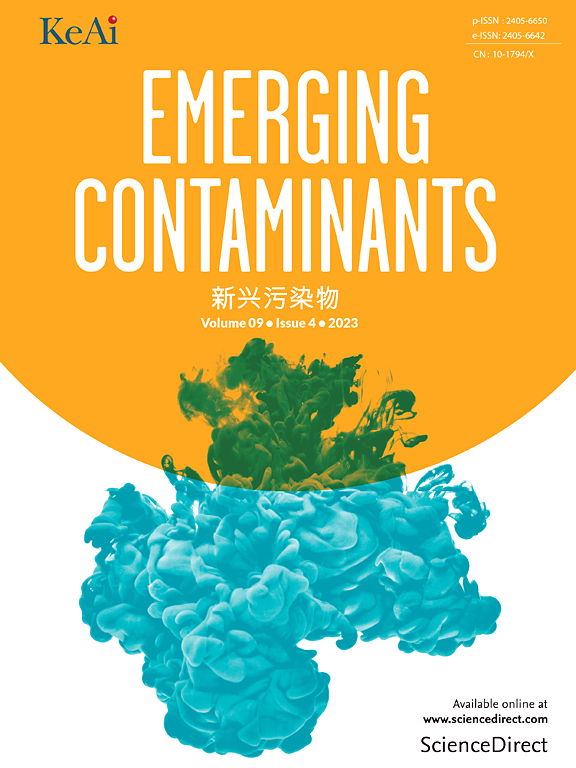海南岛主要水产养殖区抗生素耐药基因与微生物多样性
IF 6.9
2区 环境科学与生态学
Q1 ENVIRONMENTAL SCIENCES
引用次数: 0
摘要
本研究旨在了解海南省儋州、万宁、文昌和三亚4个沿海水产养殖区水生生态系统中抗生素耐药基因(ARGs)的空间分布、流行程度和多样性。进一步评估了环境参数对ARGs传播和微生物群落结构的影响。利用高通量测序对42个采样点的水样进行分析,并辅以绝对定量PCR对144个ARGs变异进行定量分析。该方法阐明了ARGs与微生物组合之间的相关性,以及环境因素对这些相互作用的影响。结果表明,每个站点检测到的ARGs数量为61 ~ 123个,其中儋州为90 ~ 123个,万宁为74 ~ 123个,文昌为68 ~ 122个,三亚为61 ~ 109个。值得注意的是,16个采样点包含超过110个arg。定量分析显示ARG浓度范围为16,167 ~ 1,784,618拷贝/ng。共现网络分析表明,大多数ARGs与MGEs、16S rRNA基因、转座子和整合子相关,表明这些元件在水平基因转移中起关键作用。微生物群落分析鉴定出72门153纲371目459科924属27050个可操作分类单位(OTUs),其中以变形菌门、拟杆菌门、放线菌门、蓝藻门和plantomycetota为优势分类群。属水平分析显示,在不同采样点,Cyanobium_PCC-6307、Candidatus_Actinomarina和HIMB11等分类群的丰度存在显著差异。pH、溶解氧(DO)、比电导(SPC)、盐度(SAL)、温度(T)和压力(kPa)等环境参数与ARG分布和微生物群落组成有很强的相关性。区域共线性网络表明微生物类群与ARGs之间存在明显的关系;值得注意的是,儋州和万宁与每属超过20个ARG表现出很强的相关性,而文昌则表现出更复杂的关联模式,表明其在ARG传播途径中的作用是多方面的。总体而言,研究结果表明,环境因素和微生物宿主显著影响海南沿海水域ARG的流行,微生物-ARG相互作用的区域差异,特别是在文昌,表明传播风险增加。这项研究为可持续水产养殖实践提供了重要见解,并为水产养殖管理的区域监管战略提供了信息。本文章由计算机程序翻译,如有差异,请以英文原文为准。
Antibiotic resistance genes and microbial diversity in major aquaculture areas of Hainan Island
This investigation aims to delineate the spatial distribution, prevalence, and diversity of antibiotic resistance genes (ARGs) within aquatic ecosystems across four coastal aquaculture zones in Hainan Province—Danzhou, Wanning, Wenchang, and Sanya. It further assesses the impact of environmental parameters on ARGs dissemination and microbial community structure. High-throughput sequencing was utilized to analyze water samples from 42 sampling sites, complemented by absolute quantitative PCR to quantify 144 ARGs variants. This approach elucidated correlations between ARGs and microbial assemblages, as well as the influence of environmental factors on these interactions. Results indicated that the number of ARGs detected per site ranged from 61 to 123, with Danzhou exhibiting 90 to 123, Wanning 74 to 123, Wenchang 68 to 122, and Sanya 61 to 109 ARGs. Notably, 16 sampling points harbored over 110 ARGs. Quantitative analysis revealed ARG concentrations ranging from 16,167 to 1,784,618 copies/ng. Co-occurrence network analysis demonstrated that most ARGs were associated with MGEs, 16S rRNA genes, transposons, and integrons, indicating these elements' critical role in horizontal gene transfer. Microbial community profiling identified 27,050 operational taxonomic units (OTUs) across 72 phyla, 153 classes, 371 orders, 459 families, and 924 genera, with Proteobacteria, Bacteroidota, Actinobacteriota, Cyanobacteria, and Planctomycetota as dominant taxa. Genus-level analysis revealed significant variations in the abundance of taxa such as Cyanobium_PCC-6307, Candidatus_Actinomarina, and HIMB11 across sampling sites. Environmental parameters, including pH, dissolved oxygen (DO), specific conductance (SPC), salinity (SAL), temperature (T), and pressure (kPa), showed strong correlations with ARG distribution and microbial community composition. Region-specific co-linearity networks indicated distinct relationships between microbial taxa and ARGs; notably, Danzhou and Wanning exhibited strong correlations with over 20 ARGs per genus, whereas Wenchang displayed a more complex association pattern, suggesting a multifaceted role in ARG transmission pathways. Overall, the findings suggest that environmental factors and microbial hosts significantly influence ARG prevalence in Hainan's coastal waters, with regional variations in microbial-ARG interactions, particularly in Wenchang, indicating heightened transmission risks. This study offers vital insights for sustainable aquaculture practices and informs regional regulatory strategies for aquaculture management.
求助全文
通过发布文献求助,成功后即可免费获取论文全文。
去求助
来源期刊

Emerging Contaminants
Medicine-Public Health, Environmental and Occupational Health
CiteScore
10.00
自引率
6.70%
发文量
35
审稿时长
44 days
期刊介绍:
Emerging Contaminants is an outlet for world-leading research addressing problems associated with environmental contamination caused by emerging contaminants and their solutions. Emerging contaminants are defined as chemicals that are not currently (or have been only recently) regulated and about which there exist concerns regarding their impact on human or ecological health. Examples of emerging contaminants include disinfection by-products, pharmaceutical and personal care products, persistent organic chemicals, and mercury etc. as well as their degradation products. We encourage papers addressing science that facilitates greater understanding of the nature, extent, and impacts of the presence of emerging contaminants in the environment; technology that exploits original principles to reduce and control their environmental presence; as well as the development, implementation and efficacy of national and international policies to protect human health and the environment from emerging contaminants.
 求助内容:
求助内容: 应助结果提醒方式:
应助结果提醒方式:


